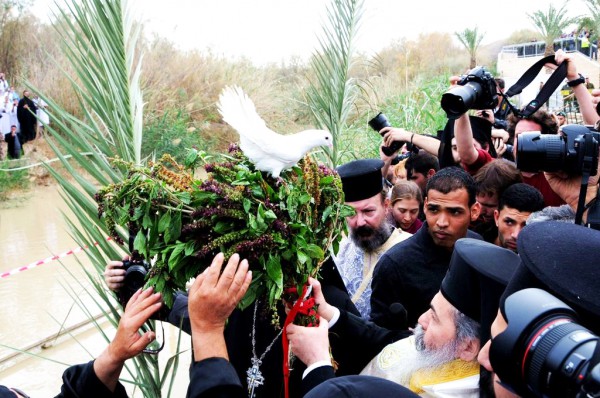
Greek Orthodox clergymen participate in the main ceremony at the Qasr el Yahud baptism site in which they bless the sacred water, release doves into the air, and toss branches.
“As soon as Yeshua [Jesus] was mikvahed [baptized], He went up out of the water. At that moment heaven was opened, and he saw the Spirit of God descending like a dove and alighting on Him. And a voice from heaven said, ‘This is My Son, whom I love; with Him I am well pleased.’” (Matthew 3:16-17)
On Sunday, the Russian Orthodox Church and Orthodox believers from around the world celebrated Epiphany (literally, Appearing), the traditional day on which Yeshua’s mikvah (Jesus’ baptism) is believed to have occurred at the Jordan River.
This momentous event is also known as the Theophany (literally, Appearance of God) because here God clearly revealed Yeshua to be His Son and anointed Him with the Holy Spirit, empowering Yeshua to begin His ministry (Matthew 3:16–17).
Over 10,000 Christian pilgrims arrived in Israel to visit Qasr el Yahud (Arabic for “the Castle of the Jew”), the Jordan River site that is believed to be the one at which Yeshua was mikvahed by Yohannan the Immerser (John the Baptist).
Qasr el Yahud is located to the east of Jericho near the northern shore of the Dead Sea.
The ceremonies at the site were rich and lively.
Ethiopian monks clothed in their colorful traditional dress accompanied the pilgrims to the baptismal site, singing and dancing to the beat of drums. They were followed by the Greek Orthodox Patriarch, Bartholomew, Archbishop of Constantinople, and others playing instruments.
Once they reached the riverbank, they dipped themselves three times as in the traditional baptism.
The spokesperson for the Jerusalem Orthodox patriarchate, Issa Elias, spoke to the crowd encouraging them to maintain their traditions and to demonstrate resilience in the midst of heavy persecution being faced by Christians throughout the Middle East today.
“My message, especially to the Christian world, is— you need to remain in your holy places, in your houses, in your churches,” Elias said. “I call on the entire world to make pilgrimage to those holy places.” (JPost)

The Greek Orthodox patriarch participates in the baptizing ritual during the Epiphany at Qasr el Yahud, Israel.
This Jordan River site came into Israeli hands in 1967 after the Six Day War but remained as a closed military zone with active land mines dotting the region until the Civil Administration transferred responsibility for the site to the Parks Authority in the year 2000.
That same year, Pope John Paul II visited the site. Pope Benedict visited it in 2009.
This particular site is also believed to be the spot at which Joshua led the Hebrew people across an overflowing Jordan 3,200 years ago, which miraculously dammed up allowing them to cross on dry land (Joshua 3:14–17).
Elijah and Elisha also crossed a dry Jordan when it parted in two. (2 Kings 2:8)
As well, after Naaman, the Aramean commander of the armies of Ben-Hadad, complied with the prophet Elisha’s counsel to dip himself seven times in the Jordan, he was healed of tzaraath (often translated leprosy).
For all these reasons, this Qasr el Yahud site is considered one of the most important in Christianity following the Church of the Nativity in Bethlehem and the Church of the Holy Sepulchre in Jerusalem. (YNet)
But it is not without controversy.
While Israel has always claimed that Yeshua’s baptism took place on the Israeli side of the river, there is some archaeological evidence that seems to point to a site on the east bank of the river in Jordan. Among the archaeological finds there is a cave believed to be where Yochanan lived.
The east bank site is called “Bethany beyond the Jordan” taken from John 1:28, which states, “These things took place in Bethany across the Jordan, where Yochanan was immersing.”
To add fuel to the fire, Pope Francis chose to hold Mass at the Jordanian site when he visited the area last spring.
The Archbishop of Canterbury as well as American evangelical pastor Rick Warren have also endorsed this site. As it stands today, pilgrims are drawn to both sides of the river to celebrate Epiphany. (Catholic Register)
The Christian rite of baptism and the immersions performed by Yochanan 2,000 years ago have their roots in Judaism’s ancient ritual immersion, which is called mikvah.
The earliest Biblical reference to a mikvah appears in 1 Kings 7:23 and its parallel passage in 2 Chronicles 4:2 that describe the “Sea of Solomon,” constructed for priests of the First Temple to conduct their ceremonial washings. (Jews for Jesus)
The mikvah has always been considered a gateway to purity, and ancient mikvahs can be found throughout Israel and even in the Jewish Diaspora. In Orthodox Judaism, it has a “primary place in Jewish life and law.” (Chabad)
The Torah requires full immersion to regain ritual purity after various events, such as coming in contact with a woman in Niddah (normal menstruation) and Zav / Zavah (abnormal blood discharge); coming in contact with a corpse, etc. Jewish priests are immersed when they are being consecrated.
In Leviticus 8:6, we read that Moses purified Aaron and his sons by washing them with water. In Leviticus 16:4, God commanded Aaron to wash himself before and after he ministered in the Holy of Holies on the Day of Atonement.
Today, Jewish Believers are immersed in the Mikvah of Yeshua as a public declaration of their death to sin (purification) and their new birth in Yeshua, the living source of all holiness:
“For we died and were buried with Yeshua by immersion. And just as Yeshua was raised from the dead by the glorious power of the Father, now we also may live new lives.” (Romans 6:4)












